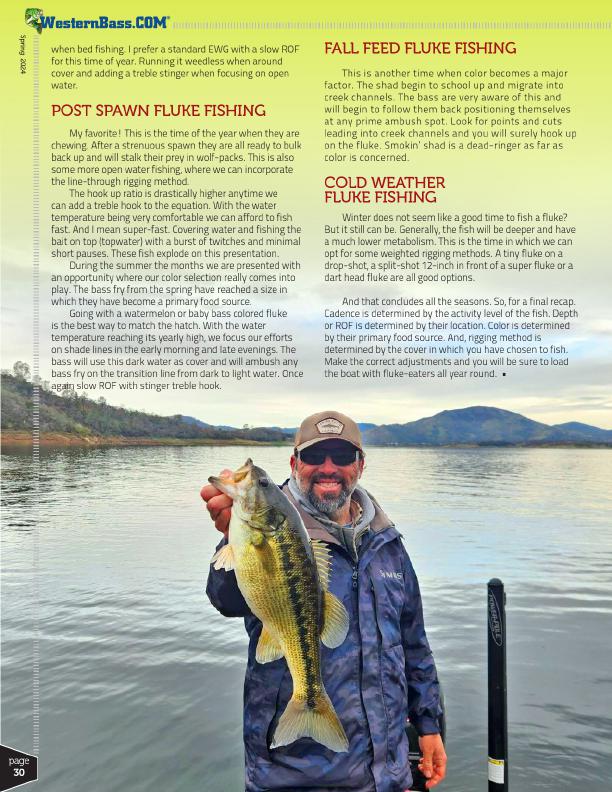
Spring 2024
®
when bed fishing. I prefer a standard EWG with a slow ROF for this time of year. Running it weedless when around cover and adding a treble stinger when focusing on open water.
POST SPAWN FLUKE FISHING
My favorite! This is the time of the year when they are chewing. After a strenuous spawn they are all ready to bulk back up and will stalk their prey in wolf-packs. This is also some more open water fishing, where we can incorporate the line-through rigging method.
The hook up ratio is drastically higher anytime we can add a treble hook to the equation. With the water temperature being very comfortable we can afford to fish fast. And I mean super-fast. Covering water and fishing the bait on top (topwater) with a burst of twitches and minimal short pauses. These fish explode on this presentation.
During the summer the months we are presented with an opportunity where our color selection really comes into play. The bass fry from the spring have reached a size in which they have become a primary food source.
Going with a watermelon or baby bass colored fluke is the best way to match the hatch. With the water temperature reaching its yearly high, we focus our efforts on shade lines in the early morning and late evenings. The bass will use this dark water as cover and will ambush any bass fry on the transition line from dark to light water. Once again slow ROF with stinger treble hook.
FALL FEED FLUKE FISHING
This is another time when color becomes a major factor. The shad begin to school up and migrate into creek channels. The bass are very aware of this and will begin to follow them back positioning themselves at any prime ambush spot. Look for points and cuts leading into creek channels and you will surely hook up on the fluke. Smokin’ shad is a dead-ringer as far as color is concerned.
COLD WEATHER FLUKE FISHING
Winter does not seem like a good time to fish a fluke? But it still can be. Generally, the fish will be deeper and have a much lower metabolism. This is the time in which we can opt for some weighted rigging methods. A tiny fluke on a drop-shot, a split-shot 12-inch in front of a super fluke or a dart head fluke are all good options.
And that concludes all the seasons. So, for a final recap. Cadence is determined by the activity level of the fish. Depth or ROF is determined by their location. Color is determined by their primary food source. And, rigging method is determined by the cover in which you have chosen to fish. Make the correct adjustments and you will be sure to load the boat with fluke-eaters all year round. •
page 30